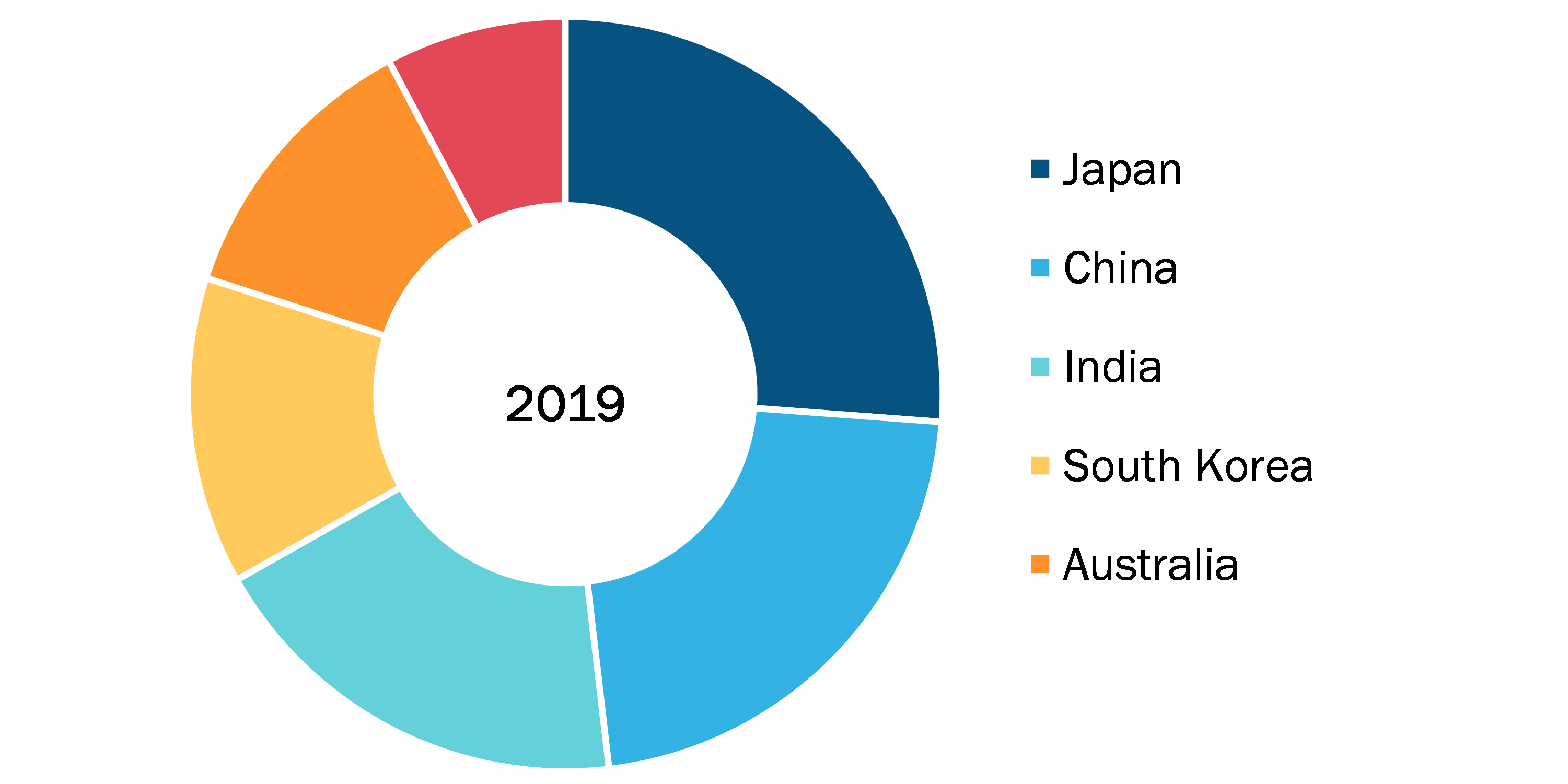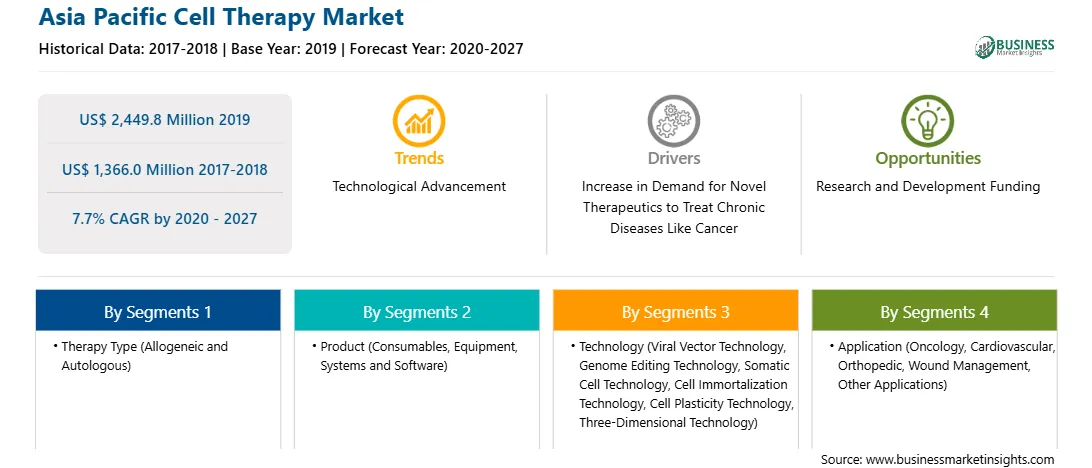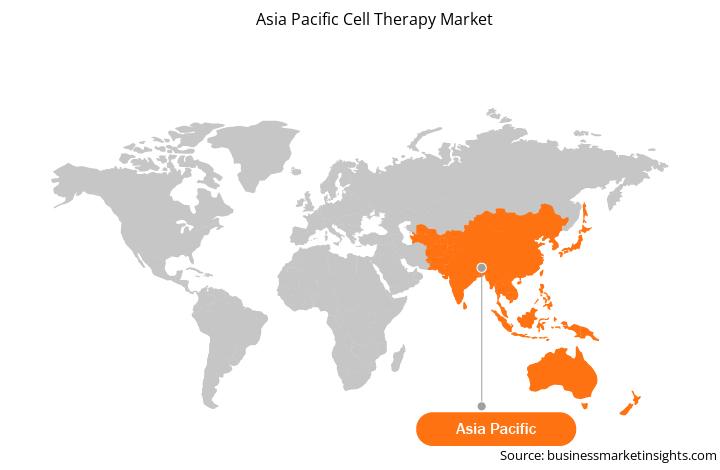This research report provides insights into the Asia Pacific cell therapy market. Cell therapy is a procedure where living and intact cells are injected, implanted, or grafted into the patient's body. This technology relies on replacing dysfunctional cells with healthy functioning ones. Cells mainly used for such advanced therapies are stem cells, because of their ability to differentiate into the specific cells required for repairing damaged or defective tissues or cells. Moreover, cell therapy also has applications in the development of regenerative medicines

Strategic insights for the Asia Pacific Cell Therapy provides data-driven analysis of the industry landscape, including current trends, key players, and regional nuances. These insights offer actionable recommendations, enabling readers to differentiate themselves from competitors by identifying untapped segments or developing unique value propositions. Leveraging data analytics, these insights help industry players anticipate the market shifts, whether investors, manufacturers, or other stakeholders. A future-oriented perspective is essential, helping stakeholders anticipate market shifts and position themselves for long-term success in this dynamic region. Ultimately, effective strategic insights empower readers to make informed decisions that drive profitability and achieve their business objectives within the market.

| Report Attribute | Details |
|---|---|
| Market size in 2019 | US$ 2,449.8 Million |
| Market Size by 2027 | US$ 1,366.0 Million |
| Global CAGR (2020 - 2027) | 7.7% |
| Historical Data | 2017-2018 |
| Forecast period | 2020-2027 |
| Segments Covered |
By Therapy Type
|
| Regions and Countries Covered | Asia-Pacific
|
| Market leaders and key company profiles |
The geographic scope of the Asia Pacific Cell Therapy refers to the specific areas in which a business operates and competes. Understanding local distinctions, such as diverse consumer preferences (e.g., demand for specific plug types or battery backup durations), varying economic conditions, and regulatory environments, is crucial for tailoring strategies to specific markets. Businesses can expand their reach by identifying underserved areas or adapting their offerings to meet local demands. A clear market focus allows for more effective resource allocation, targeted marketing campaigns, and better positioning against local competitors, ultimately driving growth in those targeted areas.

The Asia Pacific cell therapy is expected to reach US$ 1,366.0 million by 2027 from US$ 2,449.8 million in 2019. The market is estimated to grow at a CAGR of 7.7% from 2020-2027. The advancements in biotechnology have led to the adoption of personalized treatments for a wide range of indications. Stem cell therapies are being used to treat chronic diseases, such as cancer, neurological disorders, and genetic disorders. Further, the advantages of cell therapy, such as targeted treatment, faster and efficient recovery, and reduced side effects; promote the adoption of various products. In North America, cell therapies are widely adopted owing to the availability of FDA-approved products. For instance, in April 2020, the FDA awarded regenerative medicine advanced therapy designation to Novartis' Kymriah to treat refractory (r/r) follicular lymphoma (FL) in adults. In July 2020, the FDA approved a CAR T-cell therapy brexucabtagene autoleucel (Tecartus) for patients with mantle cell lymphoma. It is the first FDA-approved CAR T-cell therapy for mantle cell lymphoma and it was approved under the Accelerated Approval pathway. Tecartus also received Orphan Drug designation, which encourages the development of drugs for rare diseases. The other approved CAR-T cell therapies for cancer are Kymriah for acute lymphoblastic leukemia and Yescarta for diffuse large B-cell lymphoma. Apart from this, with more than 250 clinical trials worldwide studying CAR T-cell therapies, additional cell therapies are on their way with potential indications including pancreatic cancer, autoimmune diseases, Alzheimer’s, and Parkinson’s. This is expected to drive the cell therapy market.
The cell therapy market, by therapy type, is segmented into, allogeneic, and autologous. The allogeneic segment held the largest share of the market in 2019; however, the autologous segment is anticipated to register the highest CAGR of 8.0% in the market during the forecast period
The World Health Organization (WHO), Food and Drug Administration (FDA), are some of the major primary and secondary sources for the Asia Pacific cell therapy market included in the report.
The Asia Pacific Cell Therapy Market is valued at US$ 2,449.8 Million in 2019, it is projected to reach US$ 1,366.0 Million by 2027.
As per our report Asia Pacific Cell Therapy Market, the market size is valued at US$ 2,449.8 Million in 2019, projecting it to reach US$ 1,366.0 Million by 2027. This translates to a CAGR of approximately 7.7% during the forecast period.
The Asia Pacific Cell Therapy Market report typically cover these key segments-
The historic period, base year, and forecast period can vary slightly depending on the specific market research report. However, for the Asia Pacific Cell Therapy Market report:
The Asia Pacific Cell Therapy Market is populated by several key players, each contributing to its growth and innovation. Some of the major players include:
The Asia Pacific Cell Therapy Market report is valuable for diverse stakeholders, including:
Essentially, anyone involved in or considering involvement in the Asia Pacific Cell Therapy Market value chain can benefit from the information contained in a comprehensive market report.